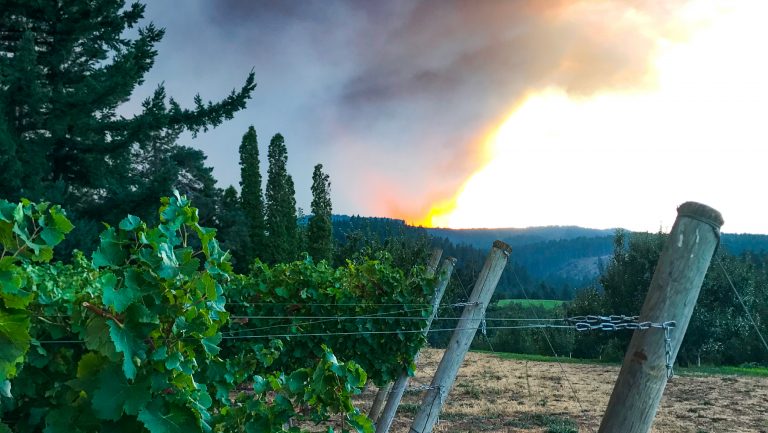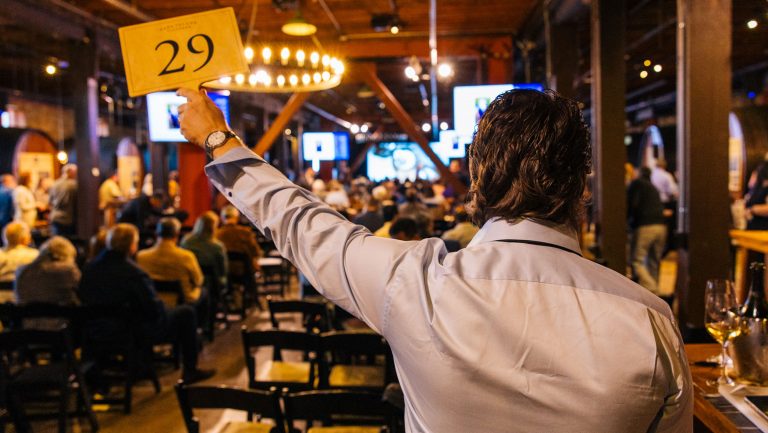The 2017 Eagle Creek fire is seared into Oregon winemaker Michael Garofola’s memory. Since February 2017 he had been working with a 0.61 acre block of Dolcetto for his Cutter Cascadia label in the von Flowtow vineyard on the west side of Hood River, and the fruit was just beginning to ripen. On September 18, the fire was raging. Hood River was on Stage 2 evacuation notice—locals might get a call at any moment to drop everything, grab their family members and pets, and get out. In the meantime, Garofola—who leases this block and farms it solo—was thinning fruit and taking samples.
“You’re out there with a bandana over your face in the vineyards,” he says. “The sky is orange. It’s just like what you imagine the last skies over Vesuvius looked like. It’s dark. It’s eerie.” That particular day, Garofola didn’t get the call. “I did my work for the day, packed up, and drove back to Portland.”
During the fire, which started on September 2 and wasn’t fully controlled until November 30, the grapes were going through véraison—the onset of ripening, when the berries change color. “If the fire had happened a month before, it wouldn’t have been a problem,” explains Garofola. “But post-véraison [the grapes] are ripening, losing acidity, but their skins are becoming more porous.” The porousness makes it easier for the skins to soak up the smoke. Phenolic glycosides contained in the smoke, such as guaiacol and eugenol, which are initially bound with sugar, break apart and become volatile during fermentation.

Don’t miss the latest drinks industry news and insights. Sign up for our award-winning newsletters and get insider intel, resources, and trends delivered to your inbox every week.
“And that’s when the shit hits the fan,” says Garofola. “I got shellacked by it.”
A Smoky Vintage
Most winemakers and critics abhor the taste of so-called smoke taint, using descriptors like “burnt,” “medicinal,” or “wet ashtray” to describe it. But instead of letting the grapes sit on the vine—as some neighboring growers did—or selling them off to the bulk market (a common practice at bigger wineries when smoke taint is detected), Garofola decided to go ahead and make a rosé and a red under his Cutter Cascadia label. Earlier this month, he released 30 cases of his rosé, called Strawberry Mullet, to Portland area shops including E&R Wine Shop, Division Wines, and Pairings Portland. He’ll bottle his red in late July.
“This is the climate of the vintage, without a doubt,” says Garofola, who is also the sommelier at Beast in Portland. “It’s not something I want to happen every year, obviously, but at the same time, I did with it what I felt was the best for the wine.” That is, he manipulated the wine as little as possible. After forest fires, some winemakers use carbon filtering, reverse osmosis, or manufactured yeast strains to mitigate or mask smoke taint, but not Garofola.
Making wine without such processes or additives was “the most authentic thing for me to do,” he says. “I’m not apologizing for the smoke. I’m not the one who started the goddamn fire! I’m just leaning into it.” Garofola says the smokiness of the rosé, which had almost no skin contact, is muted. The red—which obviously will have had more skin contact by the time he bottles it at the end of June—is a little riskier. Right now, the wine conjures a vivid sense memory for Garofola. “It reminds me of a tobacco shop my old man used to take me to in Indiana,” he says. “It smells exactly like black cherry tobacco.”
Hiyu Wine Farm winemaker Nate Ready is also unapologetic about his smoky 2017 vintage. He grows over 100 varieties at his main vineyard, five miles south of Hood River—this was the site that was most affected by the fires. In fact, Ready believes there’s a delicacy to these wines that comes from the fire, which delayed ripening and—because of the cover of smoke—created lower-alcohol grapes with a finer thread of acidity.
“The wildfires are totally part of the terroir,” says Ready. “That’s what’s so cool about wines—they reflect the culture and the ecosystem. And living in the West, we should get used to it. This is going to be part of the flavor of living in the West.”
Ready dislikes the term smoke taint because it labels a smoky character as a flaw. The smoky nature of his 2017 wines has made him more attuned to élevage, the progression of wines as they ferment in barrels. “You’re looking to take the wine to a place where these things express themselves in the cellar and evolve to a place where—Oh!—it’s more stable and compelling,” says Ready. “For sure, it’ll still change in bottle, but in ways that are more subtle.” As a result, he will probably hold the 2017 wines in barrel longer than usual. (Nothing has been bottled yet.)
Ready plans to talk openly about the forest fire’s effect on the grapes at tastings and in his newsletter. “I would just say, ‘There was a fire in 2017 and you can taste it in the wine. You can taste it structurally,’” says Ready, whose wines—he makes rosé, white, and red—are bottled under his Hiyu and Smockshop Band labels.
A Rauchwein for Aging
Barnaby Tuttle at Teutonic Wine Company in Portland is a little more brazen. Last year he committed to buying Riesling grapes from Laszlo Regos at Pear Blossom Vineyard in the Columbia Gorge. Needless to say, he didn’t anticipate a devastating wildfire—or that the grapes would come back from the lab with an exceptionally high sensory threshold level of guaiacol. Knowing that the chemical guaiacol was concentrated in the skins, Tuttle pressed the wine—whole cluster—as fast as he could. “And then I thought, ‘Hey, let’s have some fun. Let’s make a deliberately smoked wine!’” Tuttle recalls.
Tuttle explains that he and his crew crushed the fruit, did pigéage, or punch-down, and gave the wine four days on the skins. The result, which he bottled in April and calls Rauchwein (“smoke wine” in German), has an ever-so-subtle smoky scent. “I can feel it texturally on the palate,” says Tuttle, who has made enough Riesling to know what the mouthfeel should be. “And then, in the finish, there’s a kick that makes me think of mezcal.”
But the Rauchwein may become smokier over time. Teutonic’s tech notes for the wine say it’s meant to age “a long time.” Knowing that the smoky phenols may become more prominent as the wine ages, I ask if that concerns him. “I hope the taint grows in bottle,” he says. “I suppose there is a point [at which] the taint could be overwhelming, but it would have to grow exponentially for it to be a distraction. Maybe there is a risk to making interesting wines?”
After the winemakers grapple with the effects of the smoke and fire, however, it’s up to the retailers to sell the wines. Some retailers are talking up the smoked character of the 2017 vintage; others, not so much. Jeffrey Weissler, owner of Pairings Portland, has been pouring Garofola’s Strawberry Mullet for guests and is almost sold out. “People like it,” he says. “It’s an interesting, delicious, funky wine.” But he doesn’t push the forest fire angle. “It’s a sore spot for a lot of winemakers,” he says.
But Brent Braun, the sommelier at Portland’s OK Omens and Castagna, does talk to guests about the two smoky rosés he has on the by-the-glass menu at OK Omens. One is Strawberry Mullet and the other, a Dolcetto rosé made by winemaker Darryl Joannides of Viola Wine Cellars in Portland. “People love them. Especially the Strawberry Mullet because it’s so intensely smoky,” he says. “It’s so obvious. It’s fun!” Viola’s Dolcetto, on the other hand, is “lightly smoked,” says Braun. “It hits the classic notes. It’s a pretty light, refreshing patio rosé.”
Michael Wheeler of PDX Wine distributes Teutonic’s wines to restaurants and wine shops across Oregon and, when he’s doing a tasting, likes to talk about the smoky smells and flavors that resulted from the forest fires. “Or as I like to call it, terroir from the sky,” Wheeler says. “Taking what nature gave and making a true, full terroir wine—land and air. A pure wine of nature and the vintage.”

Dispatch
Sign up for our award-winning newsletter
Don’t miss the latest drinks industry news and insights—delivered to your inbox every week.
Hannah Wallace writes about food, wine, sustainable agriculture, health, and travel for CivilEats.com, Inc., Food & Wine, Vogue, Portland Monthly, and the New York Times.







